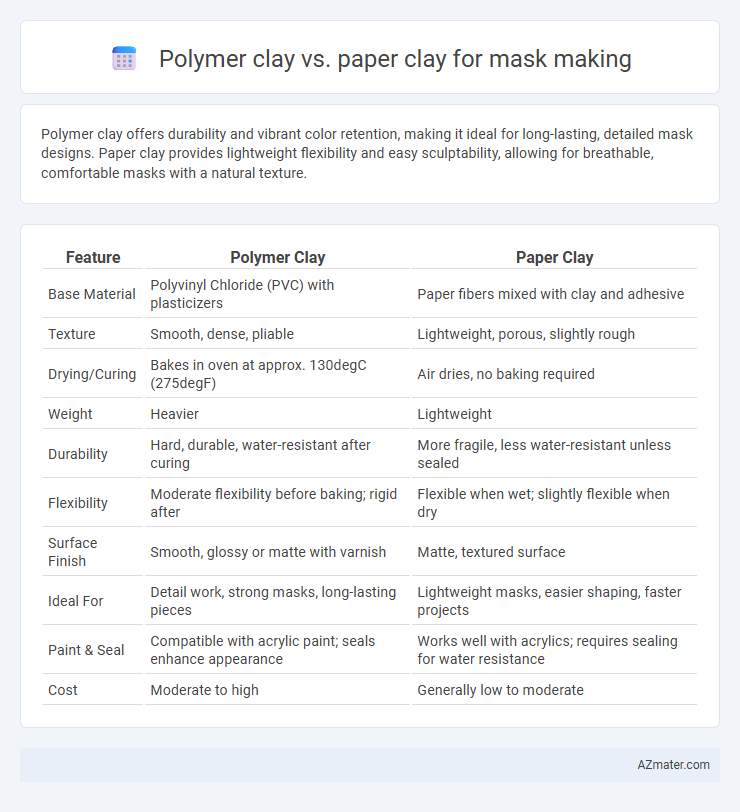Polymer clay offers durability and vibrant color retention, making it ideal for long-lasting, detailed mask designs. Paper clay provides lightweight flexibility and easy sculptability, allowing for breathable, comfortable masks with a natural texture.
Table of Comparison
| Feature | Polymer Clay | Paper Clay |
|---|---|---|
| Base Material | Polyvinyl Chloride (PVC) with plasticizers | Paper fibers mixed with clay and adhesive |
| Texture | Smooth, dense, pliable | Lightweight, porous, slightly rough |
| Drying/Curing | Bakes in oven at approx. 130degC (275degF) | Air dries, no baking required |
| Weight | Heavier | Lightweight |
| Durability | Hard, durable, water-resistant after curing | More fragile, less water-resistant unless sealed |
| Flexibility | Moderate flexibility before baking; rigid after | Flexible when wet; slightly flexible when dry |
| Surface Finish | Smooth, glossy or matte with varnish | Matte, textured surface |
| Ideal For | Detail work, strong masks, long-lasting pieces | Lightweight masks, easier shaping, faster projects |
| Paint & Seal | Compatible with acrylic paint; seals enhance appearance | Works well with acrylics; requires sealing for water resistance |
| Cost | Moderate to high | Generally low to moderate |
Introduction to Mask Making with Clays
Polymer clay offers durability and vibrant color options for mask making, allowing artists to create detailed, lightweight designs that harden with baking. Paper clay incorporates cellulose fibers, making it lightweight, flexible, and easy to sculpt, with the advantage of air drying to a matte finish that can be painted or sealed. Choosing between polymer clay and paper clay depends on desired mask texture, finishing techniques, and the level of durability required for display or wear.
Overview of Polymer Clay
Polymer clay is a versatile, synthetic modeling material composed primarily of polyvinyl chloride (PVC) combined with plasticizers, allowing it to remain soft and moldable until baked at low temperatures. Its ability to capture fine details and durability after curing makes it ideal for intricate mask designs that require strong, lightweight finishes. Unlike paper clay, polymer clay does not require drying time and offers a wide range of vibrant colors and finishes, enhancing creative possibilities in mask making.
Overview of Paper Clay
Paper clay is a lightweight, air-dry material composed of cellulose fibers blended with clay, offering excellent workability and a smooth finish ideal for mask making. It allows for easy sculpting, sanding, and painting, making it suitable for creating detailed facial features and lightweight wearable masks. Compared to polymer clay, paper clay is less durable but more breathable and requires no baking, enhancing its accessibility and safety for educational and craft projects.
Workability and Handling: Polymer vs Paper Clay
Polymer clay offers superior workability with its consistent texture, allowing detailed sculpting and extended work time due to its pliability before baking. Paper clay, lighter and air-dryable, provides easier handling for building larger structures but may crack if overworked or dried too quickly. While polymer clay requires baking for hardening, paper clay hardens naturally, influencing the choice based on drying conditions and desired finish flexibility.
Durability and Strength Comparison
Polymer clay offers high durability and strength, making it ideal for long-lasting mask creations resistant to cracking and chipping. Paper clay, while lightweight and easier to sculpt, is less durable and prone to damage from moisture, requiring careful sealing for longevity. For masks requiring robust structural integrity, polymer clay outperforms paper clay in strength and durability metrics.
Weight and Comfort of Finished Masks
Polymer clay masks tend to be heavier due to their dense, solid composition, which can cause discomfort during extended wear, especially over the face's contours. Paper clay, being lightweight and porous, offers superior comfort and breathability while maintaining structural integrity, making it ideal for masks intended for longer use. The lighter weight of paper clay reduces strain on the wearer, enhancing overall wearability without sacrificing artistic detail.
Detailing and Finish Quality
Polymer clay offers exceptional detailing capabilities due to its smooth, pliable texture that holds fine lines and intricate patterns without cracking, making it ideal for masks requiring precise features. Paper clay, composed of paper fibers mixed with clay, provides a lightweight and easily moldable medium but may lack the sharp detail definition of polymer clay, resulting in a softer, more textured finish. The finish quality of polymer clay is generally more polished and durable after curing, while paper clay masks often retain a matte, fibrous appearance that can be enhanced with sealing or painting.
Painting and Decorating Suitability
Polymer clay offers a smooth, non-porous surface that holds paint well, allowing for vibrant acrylic finishes and intricate detailing on masks. Paper clay has a porous texture that absorbs paint differently, creating a matte, textured effect ideal for layered watercolors and mixed media decoration. Both clays are versatile, but polymer clay excels in durability and color retention, while paper clay supports more tactile, organic finishes.
Cost and Availability Considerations
Polymer clay offers widespread availability in craft stores and online, with moderate pricing that suits budget-conscious mask makers; it requires no special storage, which reduces ongoing costs. Paper clay, typically more expensive due to its specialty nature and limited suppliers, may necessitate sourcing from niche art retailers, impacting accessibility for some artists. Cost-effectiveness favors polymer clay for beginners or large projects, while paper clay's unique texture and sculpting flexibility justify its higher price for detailed or professional mask work.
Environmental Impact and Safety
Polymer clay, made from synthetic materials like PVC, poses environmental concerns due to its non-biodegradable nature and potential release of harmful chemicals when heated, raising safety issues during prolonged exposure. Paper clay, composed primarily of natural fibers and clay minerals, offers a more eco-friendly alternative with better biodegradability and fewer toxic fumes, enhancing safety for artists and reducing environmental impact. Choosing paper clay supports sustainability efforts, particularly in mask making where frequent use and disposal are common.

Infographic: Polymer clay vs Paper clay for Mask making
 azmater.com
azmater.com